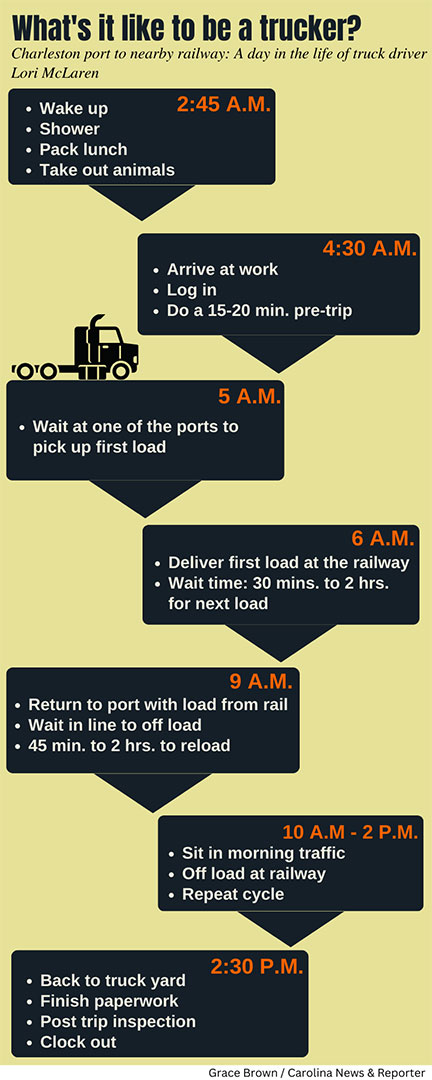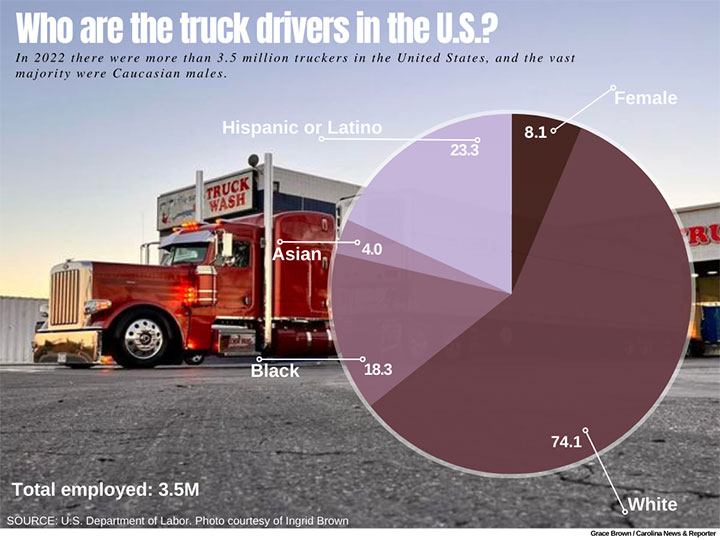Ingrid Brown outside her Fleener Bros Enterprises truck on a long haul trip (Photo courtesy of Ingrid Brown)
On her way to Missouri with a load of Krispy Kreme doughnuts in her truck, Ingrid Brown takes a lengthy Bluetooth phone call.
She’s passing through the small North Carolina town of Gastonia. The call covers everything from trucking safety, family history in the industry and ensuring women drivers are more than just a statistic.
As a female driver, Brown represents a very small part of the industry. But that’s changing.
Women have long been in the truck driving profession, but now more women are realizing they can and want to do the job.
They are challenging a male-dominated industry, even carrying on legacies or starting new ones and working to make trucking as safe as possible.
Brown has been a truck driver for almost 44 years. She retired and then came out of retirement once she realized she missed being on the road.
“I truck because I love to truck,” Brown said.
Challenging the status quo
As one generation of truck drivers begins to retire and settle into life off the road, the next group of eager drivers is close behind.
Female student drivers are right alongside male students, testing and practicing to earn their commercial driver’s license. or CDL.
“When you look at our truck driving schools and see that over 20% of them are female right now, you know it’s changing,” said Brad Ball, president of Roadmaster Driver Schools.
All 23 different driving schools Roadmaster has across the country are seeing an influx of women drivers.
“With long haul and regional and local, there’s actually a job for everybody,” said Dick Pingel, who has more than 40 years of experience as a truck driver and almost five million accident-free miles.
There has been an 88 percent increase in female drivers since 2010, according to the organization Women in Trucking.
The U.S. Department of Labor lists women drivers as 8.1 percent of the total workforce as of 2022.
So while there has been a dramatic increase in women in the trucking industry since the early 2000s, Women in Trucking is striving for even better representation.
It is working to “encourage employment, address obstacles, and celebrate success,” according to the organization’s website.
When Ellen Voie entered the trucking industry 44 years ago, women weren’t joining the profession, because there was such a lack of acceptance.
“Their response was typically, ‘Oh, we just hired the best person,’ ” said Voie, the president, CEO and founder of Women in Trucking. “It wasn’t a level playing field.”
Voie questioned why there was no association to stand behind these women. So she started Women in Trucking. That was 16 years ago.
Women drivers here, there, everywhere
Many don’t realize that women have been driving big trucks for years.
Lori McLaren practically grew up in a truck. She remembers spending summers on the road with her mother, sitting between her and her two sisters.
When it was time for McLaren to make her own career decision, she tried working as a skin-care specialist but found she really missed trucking.
She now has been a truck driver for 26 years.
Being a truck driver was also a way for McLaren to honor her mom, who was tragically shot and robbed while on the job when McLaren was a teenager. The incident left her mother paralyzed.
McLaren said all her mom could talk about was how much she missed being out on the road.
“I was like, you know what, I’ll let her live through me,” McLaren said. “And so that’s what I did.”
Brown, the driver who came out of retirement, started her career as part of a family legacy as well.
Her father had a large road construction company. She grew up learning the equipment and driving trucks.
She drove for her own company for more than 40 years. Now she’s driving for another company after deciding to get back behind the wheel.
The many years on the road have taken her through 49 of the 50 states.
“It’s amazing to see the different cultures, to see the different lifestyles, to see the different beliefs,” Brown said.
Safety, safety, safety
These women want to do their jobs.
They want to do them well and safely and continue on to their next load or home.
That means constantly pushing for safety in the trucking industry.
McLaren said drivers must pay attention to what’s happening around them and their trucks at all times.
“If something doesn’t feel right, don’t get out of your truck,” McLaren said. “If it takes you calling someone you’re riding with, pair up, go in together. You’re safer in numbers.”
Brown echoed that same message. She stays aware 24 hours a day when on the road and hasn’t had many problems.
“There are so many safe people, but you can’t let your guard down,” Brown said.
A Women in Trucking study of male and female drivers found that on a scale of 1-10, with 10 meaning the driver felt completely safe, the average driver ranked their safety at only 4.4.
“We also found out that about 24% of our members are carrying firearms because they don’t feel safe,” Ellen Voie said.
Women in Trucking is working to create panic buttons or better alarm systems with truck cab manufacturers. They work with truck stops on security and carriers about where they send drivers to offload.
Driving schools are adamant about putting safety at the forefront of their teaching. They want to keep their students and the people driving around them safe.
“Everyone that walks in the door is hit with safety, from day one to the day they graduate because it’s at the core of everything we do,” Brad Ball said. “It has to be, because we want to make sure that we’re putting safe, professional drivers on the road.”
Bridging the gap
Technology and the advancement of the trucks themselves are helping to create an industry that is more available to anyone who wants to join.
McLaren recalls her mom having two gear shifts when she was driving. When McLaren started driving, she had only one. Now, drivers shift gears with knobs.
“The trucks are automatic now,” Ball said. “For the most part, much of trucking is no-touch freight.”
Importantly, trucking is an industry where there’s no pay gap based on race or gender.
It’s all about the load.
“You’re paid by the mile, by the load, by the percentage,” Voie said.
Brown said the load doesn’t care who’s picking it up — the load just needs to arrive safely from point A to point B.
And, as more women change the industry, the more clear a driver’s career path becomes.
“I think that if there was a bridge to be built amongst drivers, I honestly think that that would be a bridge between the males and females — to where women would see that they’re wanted, they’re needed and that they have a place,” Brown said.







